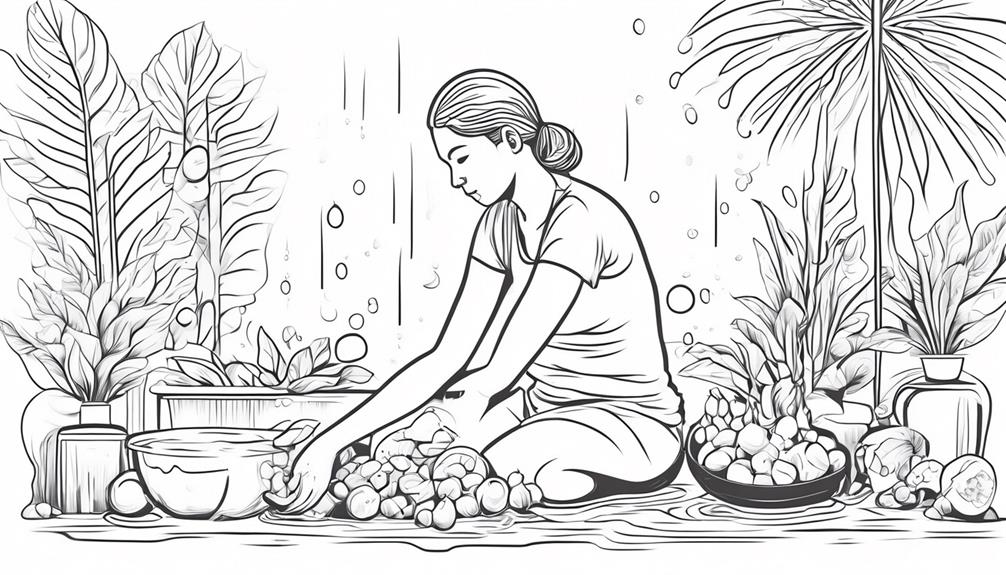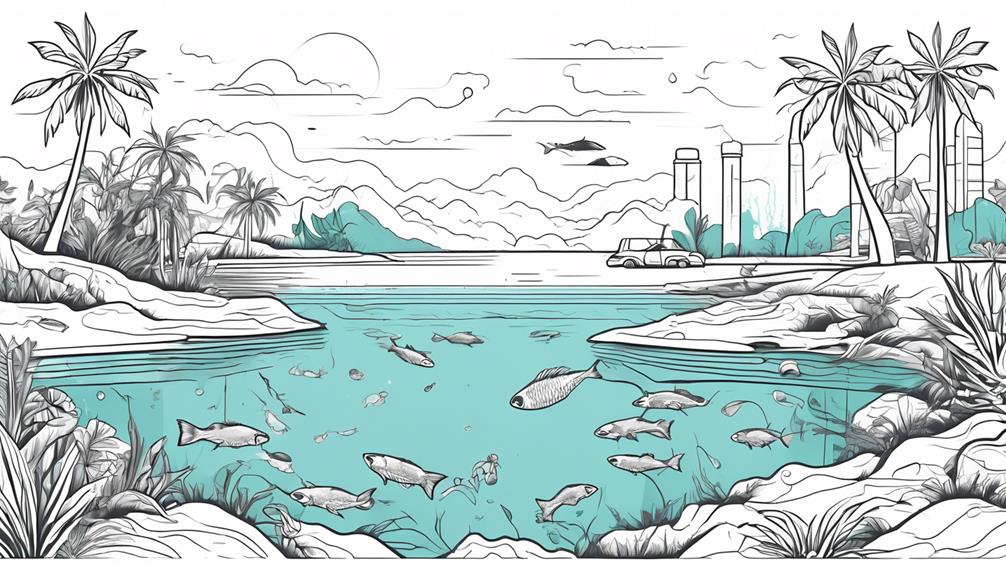When navigating the dense jungle of preventing waterborne diseases in tropical regions, think of water as the lifeblood of communities but also as a potential carrier of unseen threats. Imagine a lush oasis hiding dangers beneath its shimmering surface.
From the murky depths of contaminated rivers to the deceptive clarity of seemingly pure springs, the risks are omnipresent. But fear not, for within these pages lie strategies to help you safeguard against these hidden perils.
From understanding the sources of contamination to implementing effective treatment methods and fostering community involvement, this guide will equip you with the knowledge needed to protect the health of those in tropical regions.
Key Takeaways
- Recognizing warning signs of waterborne diseases is crucial for early treatment and prevention.
- Implementing effective water treatment methods such as filtration and chlorination can help remove harmful bacteria and viruses.
- Community education and engagement play a vital role in preventing waterborne diseases through workshops and awareness campaigns.
- Sustainable water management practices like rainwater harvesting and conservation efforts are essential for long-term health benefits in tropical regions.
Importance of Water Quality
To ensure safe drinking water in tropical regions, understanding the importance of water quality is crucial. Water quality refers to the condition of the water, including its chemical, physical, and biological characteristics. In tropical areas, where waterborne diseases are prevalent, ensuring high water quality is essential for maintaining public health.
Contaminated water can spread diseases like cholera, typhoid, and dysentery, causing severe illness and even death. Poor water quality can result from various factors such as sewage contamination, agricultural runoff, and inadequate sanitation practices. By comprehending the significance of water quality, you can grasp the direct link between clean water and overall well-being.
Visualize a scenario where a community drinks water from a polluted source. The water may appear murky or have a foul odor, indicating contamination. Understanding water quality helps you recognize these warning signs and take necessary precautions to avoid waterborne illnesses. By prioritizing water quality, you contribute to safeguarding public health and promoting a healthier environment in tropical regions.
Common Waterborne Diseases
Hey there! Let's talk about the common waterborne diseases you might encounter in tropical regions. From stomach bugs to skin infections, these diseases can really knock you off your feet.
Stay tuned for quick and effective prevention methods to keep you healthy and enjoying your time in the tropics!
Disease Symptoms Overview
Waterborne diseases can manifest with a variety of symptoms, impacting individuals in tropical regions. Common symptoms include diarrhea, vomiting, stomach cramps, and fever. These signs often arise due to ingesting contaminated water containing harmful pathogens like bacteria, viruses, or parasites.
Skin rashes, dehydration, and fatigue are also prevalent indicators of waterborne illnesses. In severe cases, individuals may experience neurological issues, respiratory problems, or organ failure. Recognizing these symptoms early is crucial for prompt treatment and recovery.
If you suspect waterborne disease, seek medical attention immediately. Remember to stay hydrated, practice good hygiene, and avoid consuming untreated water to lower your risk of contracting these illnesses in tropical areas.
Prevention Methods Summary
In preventing common waterborne diseases, adopting proper hygiene practices is key to safeguarding your health in tropical regions. To stay healthy, follow these simple steps:
- Boil or treat water: Ensure all drinking water is boiled or treated to kill harmful bacteria and parasites.
- Practice good hand hygiene: Wash your hands frequently with soap and clean water, especially before eating.
- Avoid swallowing water: Refrain from swallowing water while swimming or bathing in potentially contaminated sources.
- Proper food handling: Cook food thoroughly and avoid consuming raw or undercooked foods to prevent waterborne illnesses.
Sources of Contamination
Amidst the lush landscapes and vibrant ecosystems of tropical regions, various sources contribute to the contamination of water, posing significant risks for waterborne diseases. One major source of contamination is untreated sewage. In many tropical areas, inadequate sanitation systems can lead to raw sewage seeping into water sources, carrying harmful pathogens.
Agricultural runoff is another significant contributor. Pesticides, fertilizers, and animal waste can wash into rivers and lakes, polluting the water and making it unsafe for consumption.
Industrial activities also play a part, with factories often releasing chemicals and toxins that find their way into water bodies. Moreover, improper waste disposal, such as littering and dumping of garbage, can introduce bacteria and other contaminants into the water supply.
Lastly, natural events like floods or heavy rainfall can wash debris and pollutants into water sources, further exacerbating the contamination. Understanding these sources can help in implementing targeted strategies to prevent waterborne diseases in tropical regions.
Effective Water Treatment Methods
When tackling water treatment in tropical areas, you'll want to focus on two key methods: filtration systems and the chlorination process.
Filtration systems work like a sieve to catch impurities, while chlorination uses chemicals to kill harmful microorganisms.
Picture a multi-step process where water flows in dirty and comes out clean, ready for safe use in homes and communities.
Filtration Systems
Consider using a high-quality filtration system to effectively treat water in tropical regions. Here are some advantages of filtration systems:
- Removes Microorganisms: Filters can trap bacteria, parasites, and other harmful microorganisms.
- Improves Taste: Filtration can enhance the taste and odor of water by removing contaminants.
- Easy Maintenance: Many filtration systems are easy to maintain and require minimal effort.
- Cost-Effective: Investing in a filtration system can be cost-effective in the long run by reducing the need for bottled water or expensive treatments.
Using a filtration system can significantly improve the quality of water, making it safer and more enjoyable to consume in tropical areas.
Chlorination Process
Enhancing water quality in tropical regions can be efficiently achieved through the chlorination process, a highly effective water treatment method. Chlorination involves adding chlorine to water to kill harmful bacteria and viruses, making it safe for consumption. This process effectively destroys various disease-causing microorganisms, safeguarding the health of communities.
Imagine chlorine as a shield, protecting water from unseen dangers. It acts as a powerful disinfectant, neutralizing contaminants and ensuring that water is clean and safe. Chlorination is widely used in water treatment plants worldwide due to its proven effectiveness in preventing waterborne diseases.
Hygiene and Sanitation Practices

To maintain good hygiene and sanitation practices in tropical regions, regularly wash your hands with soap and water. This simple practice can go a long way in preventing the spread of waterborne diseases.
Additionally, here are some key tips to help you maintain proper hygiene and sanitation:
- Proper Waste Disposal: Dispose of waste in designated areas to prevent contamination of water sources.
- Boil or Treat Drinking Water: Ensure that water for consumption is either boiled or treated to kill harmful microorganisms.
- Use Sanitary Facilities: Always use clean and safe toilets to avoid polluting the environment and spreading diseases.
- Keep Food Preparation Areas Clean: Thoroughly wash all fruits and vegetables and ensure that cooking surfaces are sanitized to avoid food contamination.
Community Engagement Strategies
To effectively combat waterborne diseases in tropical regions, fostering community engagement is crucial for implementing sustainable solutions and promoting long-lasting positive health outcomes. Engaging with the community involves educating and involving individuals in understanding the importance of clean water, proper sanitation, and hygiene practices. One effective strategy is to organize community workshops or meetings where locals can learn about waterborne diseases, their causes, and prevention methods in a simple and visual manner.
Encouraging community members to take ownership of water sources and sanitation facilities can lead to better maintenance and sustainable usage. Implementing community-led initiatives such as establishing water committees or hygiene promoting groups can empower individuals to actively participate in safeguarding their health and wellbeing.
Additionally, leveraging local leaders and influencers can help spread important messages more effectively within the community. By working together and fostering a sense of responsibility towards water and sanitation practices, communities can create a healthier environment for all residents, reducing the prevalence of waterborne diseases in tropical regions.
Impact of Climate Change

Climate change impacts water availability and quality in tropical regions, posing significant challenges to public health and sanitation efforts. As temperatures rise and weather patterns become more erratic, the following consequences are observed:
- Increased Flooding: Heavy rainfall events lead to flooding, overwhelming sewage systems and contaminating water sources.
- Droughts: Prolonged dry spells reduce water availability, leading to water scarcity and forcing communities to use unsafe water sources.
- Rising Sea Levels: Coastal regions face saltwater intrusion, contaminating freshwater sources and increasing the risk of waterborne diseases.
- Extreme Weather Events: Hurricanes and cyclones disrupt water infrastructure, causing contamination and compromising access to clean water.
These impacts highlight the urgent need for adaptive strategies and sustainable water management practices to safeguard public health in tropical regions. By understanding and addressing the effects of climate change on water sources, communities can better prepare for and mitigate the risks associated with waterborne diseases.
Government Policies and Interventions
As tropical regions grapple with the impacts of climate change on water sources, government policies and interventions play a crucial role in mitigating waterborne diseases and ensuring public health. One key government intervention is the establishment of water quality standards and regulations. These standards set clear guidelines for safe drinking water, ensuring that water sources are regularly tested and treated to prevent contamination.
Governments also invest in infrastructure projects to improve water access and sanitation facilities in communities. By building water treatment plants, sewage systems, and promoting hygiene education, authorities can significantly reduce the spread of waterborne illnesses.
Furthermore, public health campaigns are launched to raise awareness about the importance of clean water and proper sanitation practices. These initiatives often include distributing water purification tablets, promoting handwashing, and encouraging the use of safe water storage containers.
Frequently Asked Questions
How Can Individuals in Tropical Regions Test the Quality of Their Drinking Water at Home?
To test your drinking water at home in tropical regions, grab a water testing kit. Follow the instructions to check for contamination. If results show issues, take necessary steps like boiling or purifying your water to stay safe.
Are There Any Natural Remedies or Traditional Practices That Can Help Prevent Waterborne Diseases in Addition to Modern Water Treatment Methods?
To prevent waterborne diseases in tropical regions, consider combining modern water treatment methods with traditional practices like boiling or filtering water. These can complement each other, providing added protection against harmful pathogens and ensuring safe drinking water.
What Are Some Common Misconceptions About Waterborne Diseases in Tropical Regions?
Common misconceptions about waterborne diseases in tropical regions include believing that only visibly contaminated water is unsafe, assuming chlorine alone can purify water completely, and thinking that boiling water for a few seconds is sufficient.
How Do Waterborne Diseases Affect Vulnerable Populations Such as Children, Elderly, and Pregnant Women in Tropical Regions?
Waterborne diseases pose significant risks to vulnerable populations in tropical regions. Children, elderly, and pregnant women are at higher risk due to weaker immune systems. Proper sanitation and access to clean water are crucial for protection.
Are There Any Ongoing Research Projects or Innovations in Water Treatment Technology Specifically Tailored for Tropical Regions?
When it comes to ongoing research and innovations in water treatment technology for tropical regions, there are indeed exciting projects underway. Scientists and engineers are developing new methods to ensure clean water for all.
Conclusion
Don't let waterborne diseases rain on your parade in tropical regions! By staying informed about water quality, practicing good hygiene, and engaging with your community, you can prevent these pesky illnesses from ruining your fun in the sun.
Remember, a little prevention goes a long way in keeping you healthy and happy. So, dive into action and make a splash in the fight against waterborne diseases!
